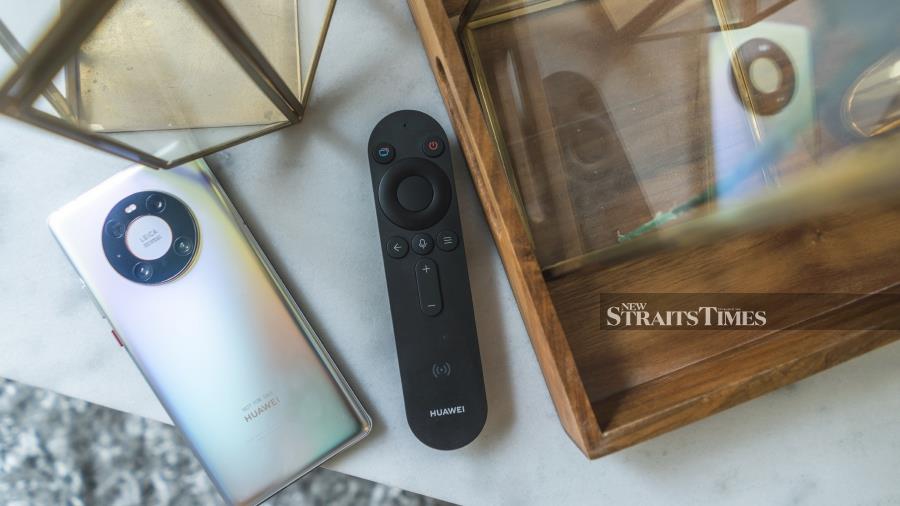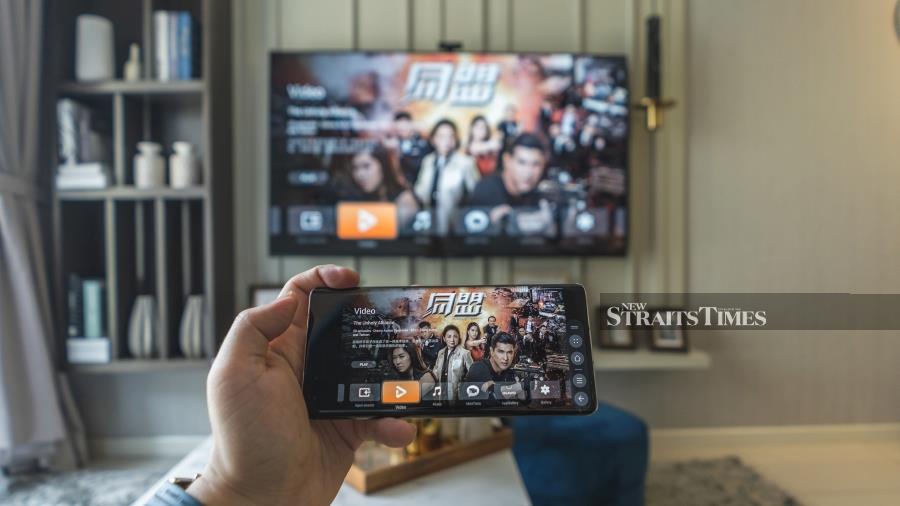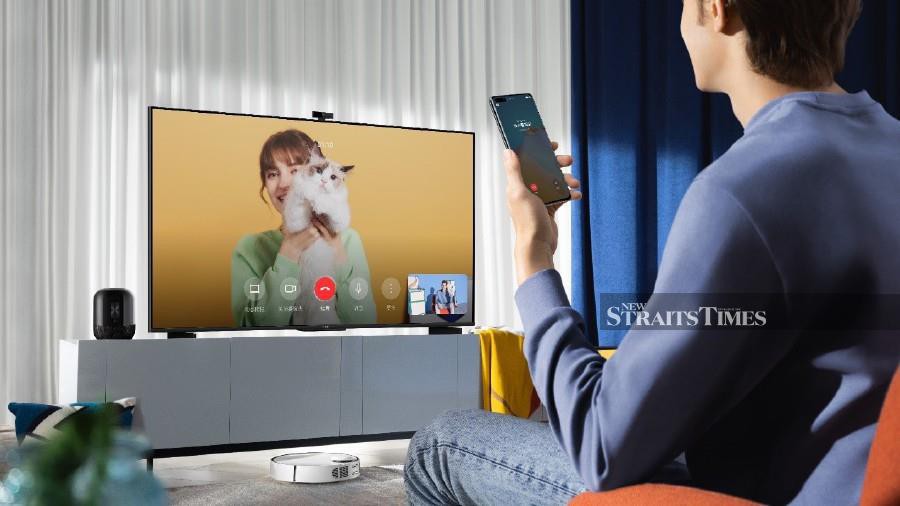HUAWEI recently launched the Vision S Series smart TV.
I managed to get my hands on it for a review. Armed with a Wifi connectivity and an android smartphone (which needs to run on EMUI 10.0 or later), the exploration of this brand new TV began.
The Huawei Vision S Series is not merely a smart TV, but rather a product for something far more ambitious – intelligent, interactive home-bound devices that make full use of emerging technologies like artificial intelligence (AI) and IoT. Designed with young users in mind, redefining what "smart TV" is capable of, and raising the bar for IoT device R&D, the Vision S Series is able to meet the many needs of current consumers.
LOOK AND FEEL
I am all about looks when it comes to devices. Featuring what is called a FullView design, the Vision S boasts a whopping 94 per cent screen-to-body ratio encased in a metal frame, giving it a sleek and sturdy feel, despite being so thin.
The simplified industrial design reduces the visual impact of other unrelated fields of view and directs my attention to the gigantic display making movie nights an experience on its own.
At first, I wasn't sure about the ice skating shoe-shaped metal base but the moment it was fastened and the Vision placed, I found that it gives the support the TV needs and very unlikely would lose balance and topple (I did on a couple of occasions accidentally knock on the TV while walking half asleep and let me tell you, it can withstand accidental brushes, tried and tested, accidentally of course).
The Vision does not only feature a clean front, its back shell too offers a 'clean' feel. The port placement on this device was definitely well thought of because I manage to escape the wire clutter I'm used to seeing with my TV ensemble.
MORE FOR LESS
Wires from multiple devices contribute to the clutter. Of course the built-in speaker on the TV (well, in this case, mine) doesn't give the proper surround sound for an immersive audio-viewing experience hence the need of having an additional soundbar and speaker set, hence the additional wiring setup going around the TV and the house too, my house.
Housing four 10W speakers - two being full frequency speakers and two high frequency speakers along with a large 1L sound cavity that ensures the bass is vigorous and powerful, I don't see (or hear) the need for an additional speaker system.
The hardware set-up on this TV achieves excellent frequency response, allowing the Vision to play ultra-wide range of frequencies faithfully. The tweeters patented high-sensitivity design effectively boosts the radiation efficiency of sound power, rendering treble notes in greater clarity and enhanced detail. Another way of putting it, it sounded great!

MULTI-DEVICE COLLABORATION
Known for its multi-device collaboration, with a vision of a seamless AI Life ecosystem, Huawei did not forget to include the same feature on the Vision. HarmonyOS-enabled, this TV, which by now you would have realised that it is more than just a TV, supports OneHop projection. But what is a OneHop projection?
OneHop projection is a Miracast wireless projection that allows Huawei users to project their phone screen to a larger display, in this case, the Vision. All I did was tap on the Huawei Share icon on the Huawei Vision remote control and voila! My phone screen is projected on the Vision. But of course, for this to work, you would need to tap your phone to the Vision remote control for it to pair as the Vision remote control has a built-in NFC tag that allows the OneHop feature to work and, your smartphone must also be an NFC enabled phone that run EMUI 9.1 or later.
Not limited to OneHop features, the Vision S also comes with smart control. Same difference, if the OneHop lets me utilise the huge screen, the smart control allows me to navigate the TV from my phone making channel switching, video browsing and video calling can be done on the phone itself. To do this, just download the Huawei Vision app, and make sure both your phone and the Vision are connected to the same WiFi network and logged on to the same Huawei ID too. But hey, it's your TV at your home, whose ID and network would you use, right?
A TELEVISION WITH CAMERA
Remember I said earlier that a video call is possible with the Vision S? Not all computer monitors come with cameras which enable you to enjoy video calls or conferencing like a laptop does, let alone a TV.
The Vision S is not your typical TV set.
Understanding how smartphones are currently the most intelligent devices used on an everyday basis, thanks to their state-of-the-art processors and sensors, Huawei incorporated similar principles into the making of the Vision S too. Realise how we rely much on the front camera when we try to stay connected to our loved ones in this pandemic-stricken era? The Vision S comes with a removable magnetic suction design camera that allows 180 degree rotation and easy removal - to address both security and aesthetics issues.
The Huawei Vision S Series supports a maximum resolution of 1920 x 1080. Imagine a video call on a 65-inch screen with that resolution, it feels like you are in the same room, talking to each other sitting in front of one another.
The calls can be made through the MeeTime Video feature which works between two Vision models, or between a Huawei Vision S and a phone or tablet with MeeTime features installed.
Besides that, the camera works very well in capturing selfies just like your smartphone does, only bigger and wider. And, remember the OneHop feature? Photos taken on the TV can easily be shared on to your phone and vice versa, seamlessly.

STUNNING PICTURES
The Huawei Vision S Series directly uses 120Hz screens unlike other similarly priced products that only offer a 60Hz refresh rate.
But can you tell the difference? Honestly, I can't (at first).
Having a higher refresh rate doesn't add any substantial value, meaning you can't exactly tell the difference but as amazing as the human body works, our eyes do catch the slightest change. Try going back to your old TV set after spending a week watching movies on the Vision, then you'll notice it. I did.
There's a lot of technical explanation when it comes to explaining how the Vision S has stunning colours compared to the other TV.
To make it easier for everyone to understand, the Huawei Vision S Series comes with an innovative backlight solution that realises expansive colour coverage that far exceeds those on conventional LCD screens. Its meticulous model-by-model colour calibration ensures that each model reproduces rich and natural colours to maintain unified picture quality. The high-level intelligent colour accurate toning algorithms are also deployed in the Vision to analyse pictures, to ensure rich and real natural colours are displayed.
The Vision S Series is a veritable FullView for eye protection. It takes eye care as an important feature to enhance the user's eye protection.
Flickering screens are caused by fluctuations in display brightness and visible flickers, characterised by low-frequency ripples, can lead to eye irritation and dry eyes, especially over the long haul.
Non-visible high-frequency flickers, on the other hand, are not directly perceptible to the naked eye, but are actually visible to the retinal cells – this means retinal cells will command corresponding eye muscles and nerves to react to the changing brightness, which then still causes eye fatigue, and in some cases, even headaches.
This TV utilises flicker-free technology consisting of DC dimming and flicker calibration to lower the amplitude of the fluctuating brightness and thereby eliminating flickers to achieve fliker-free viewing.
Blue light is a harmful spectrum, which encompasses the 440–480 nm wavelength range, penetrates through the cornea and lens all the way to the retina, inducing photoreceptor damage and producing free radicals in the long run, which can lead to macular degeneration and retinal pigment epithelial cell death. In short, it is bad for our eyes.
The Vision S applies low blue light technology to protect the eyes, in which the peak energy of the harmful spectrum is debugged and reduced so that it meets the Risk Exempt requirements for photo-biological safety, meaning the display poses no photo-biological hazard which also means, Vision is safer than other blue light screen with no protection out there.
To enable blue light safety, changes need to be made from the settings menu. Please note that once you activate the blue light filter, the display will have a slight yellowish tint. Please note that your Vision is not broken, it's working, it is protecting your eyes' health.
ENTERTAINMENT FRIENDLY
Gaming on a TV can be a bit distracting because unlike gaming monitors, TV has a lower refresh rate.
Huawei's new distributed gaming feature is an all-new cross-device entertainment function in HarmonyOS, and is available for games that support Huawei's distributed technology. When such a game is installed and run on a Vision, the connected phone can serve as the game handle. This is particularly exhilarating for games that involve a gravity sensor or gyroscope where the phone's sensors are automatically invoked by the distributed capabilities.
Although to date, this feature is only available on certain single-player games and the list is available on Huawei Vision's AppGallery.
To enable this feature, open a game on the Vision and connect your phone to it. Next, open the Huawei Vision app on your phone and touch the smart control function to use your phone's gyroscope to steer the game for sharper and smoother image rendering.
The phone's sensor is automatically invoked by the distributed technology, which allows for more natural controls.
The latency is brought down to as little as 30ms, far lower than that for gaming projection.
Distributed gaming works on a wider range of phone models, as it only requires the installation of the Huawei Vision app.
Another entertainment feature on the Vision S is that it supports karaoke features. Now karaoke sessions can happen at the safety and comfort of your own home.

MORE INTELLIGENCE
The Huawei Vision S Series also supports uninterrupted music playback even when its screen is off. Even with its screen turned off, the Vision remains as smart and can still process voice commands. Just command a song or a movie, and Vision will find it for you. All you need to do is call Celia, the AI assistant and let Celia know what you need.
Calls "Hey, Celia!" and Celia shall oblige. Celia currently speaks two languages, English and Malay and will soon be able to understand many other languages. For my use, these two languages are all I need.
OVERALL
After spending some screen time on the Vision, I realised that it is what its maker claims it to be - more than a TV.
Having to attend multiple conferences, it comes to my realisation that the Vision would work wonders for students as well as it has for me. Having a smart TV that allows two-way communications on such a large screen would benefit the young (as much as adults) too. Learning would be easier on big screens in comparison to the small smartphone screens children are made to use while remote learning.
Although Huawei has yet to officially announce the price for the Vision, an affordable price tag would definitely make the Vision S Series a hit.
Price: From RM2,999
Verdict: 3.5
Shop Huawei home electronics at best prices with Lazada Voucher.







